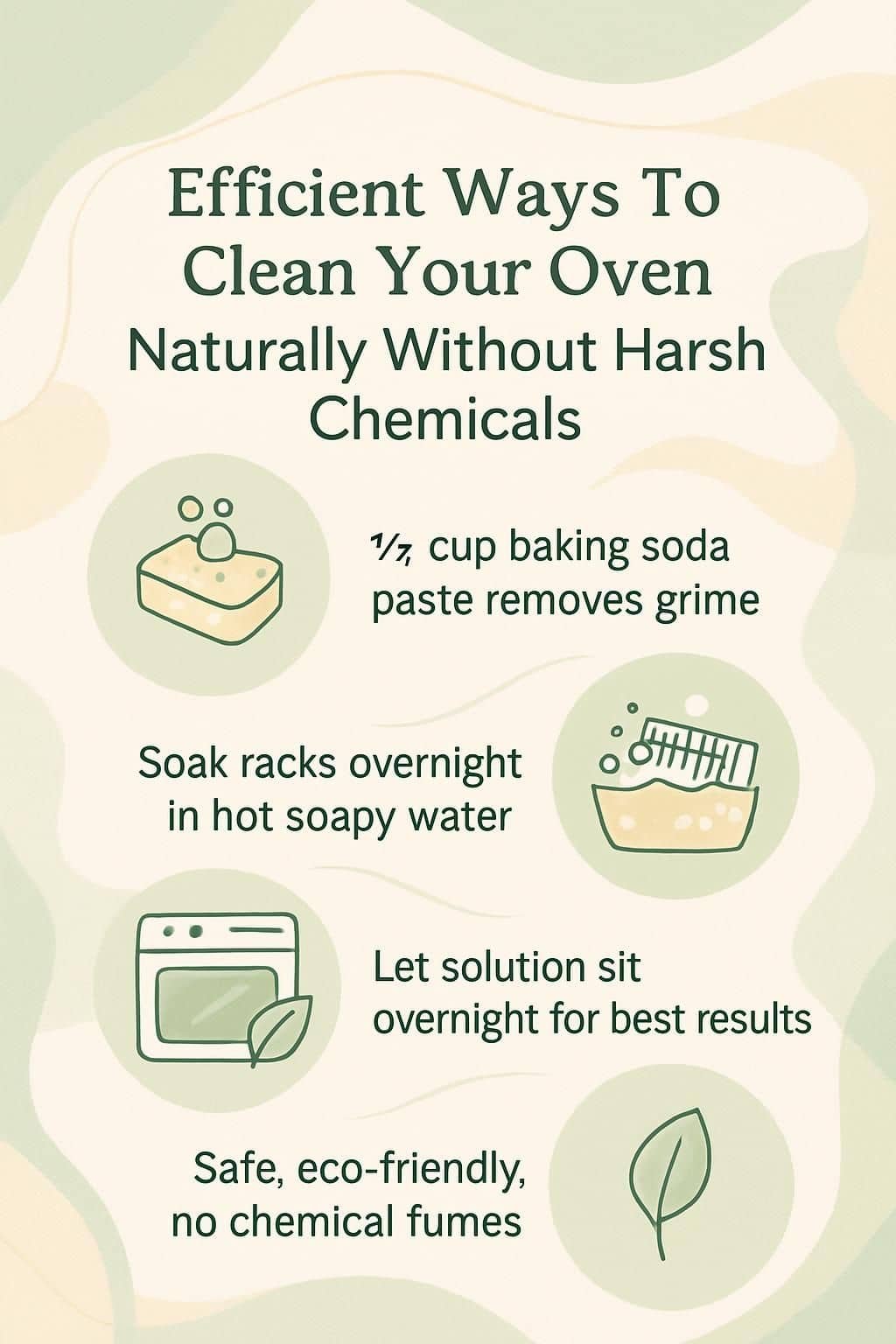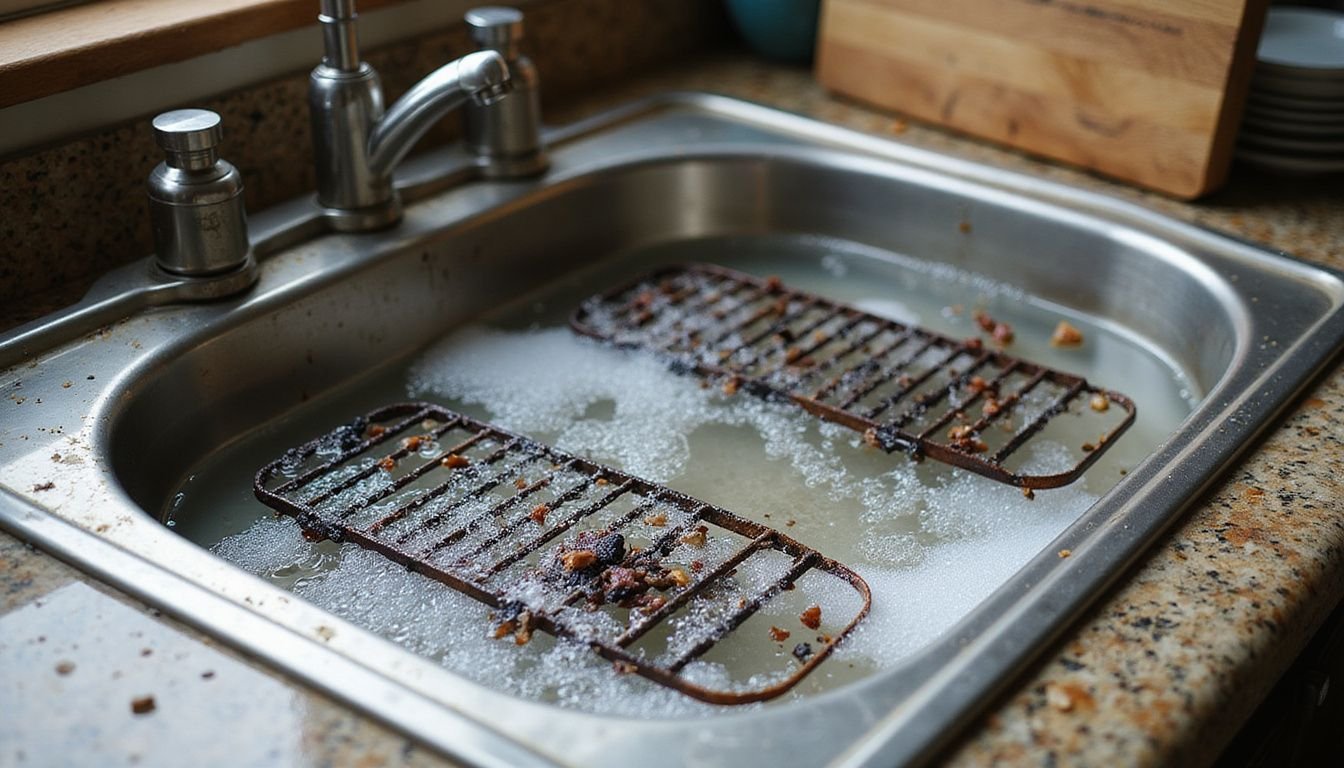Cleaning an oven can feel like a big chore, especially if there is burnt food and greasy stains inside. Many people want efficient ways to clean the oven naturally without harsh chemicals.
Strong cleaners often leave behind smells that are not safe for kids or pets.
Studies show that natural cleaning solutions such as baking soda and vinegar can break down tough grease almost as well as store-bought chemical cleaners. These simple home remedies work safely and are less risky around your family.
This guide explains How To Clean Your Oven with ecofriendly and nontoxic methods using easy steps anyone can follow at home. You will learn how to deodorize, remove grease, and tackle baked-on messes with ingredients already in your kitchen cabinet.
Discover quick hacks to keep your oven fresh and spotless—read on for tips you will actually use!

Prepare Your Oven for Cleaning

To prepare your oven for cleaning, start by emptying it completely. Next, remove the oven racks and soak them in warm, soapy water to loosen any grime.
Empty the oven
Take out all baking trays, pans, and any loose items from the oven. Clear away any crumbs or bits of food using a dry cloth or paper towel. Removing everything helps create space for natural cleaning and makes it easier to reach every corner.
Experts in ecofriendly cleaning stress this step for safety and better results. A bare oven also prevents nontoxic cleaners from reacting with leftover grease on dishes or racks.
Cleaning starts with a blank slate—an empty oven gives you full access, says certified green cleaner Maria Sanchez.
Remove and soak the oven racks
Cleaning the oven is a task that often gets overlooked. Yet, for house owners and parents seeking ecofriendly cleaning solutions, it’s a crucial part of kitchen maintenance. Here’s how to remove and soak the oven racks for an effective clean without harsh chemicals:
- Pull out the oven racks gently from the oven. Make sure the oven is cool and not in use.
- Fill your sink or a large tub with hot water until it’s enough to fully submerge the racks.
- Add half a cup of baking soda and a few squirts of ecofriendly dish soap to the hot water.
- Place the oven racks into the soapy water mixture carefully.
- Ensure each rack is fully submerged by pushing them down if they float up.
- Leave the racks to soak overnight, allowing the solution time to loosen grease and grime.
- Scrub any tough spots with a non-toxic abrasive pad after soaking, focusing on areas with heavy buildup.
- Rinse each rack with clean water thoroughly, washing away all residue from the cleaning solution.
- Dry the racks completely with a soft cloth or towel before placing them back in the oven.
This process prepares you well for creating and applying a natural cleaner to your oven surfaces next.
Create a Natural Cleaning Solution
Creating a natural cleaning solution is simple and effective. Mix baking soda with water to form a thick paste that cuts through grease easily.
Make a baking soda paste
Mix one-half cup of baking soda with three tablespoons of water to form a spreadable paste. Baking soda acts as a gentle abrasive cleaner. This nontoxic cleaning solution helps break down burnt-on grease without releasing toxic fumes.
Many home remedies recommend this method for safe oven maintenance, especially around kids and pets.
Parents use this baking soda paste because it can deodorize while lifting stubborn buildup from racks and surfaces. The ecofriendly formula won’t scratch metal or glass, making it ideal for regular natural cleaning in busy kitchens.
Baking soda remains the safest choice for those wanting efficient ways to clean your oven naturally without harsh chemicals.
The next step will show how to apply this homemade cleaner directly onto greasy or baked-on areas inside the oven.
Optional: Add vinegar for tough stains
Adding vinegar to the baking soda paste helps tackle tough stains effectively. Vinegar enhances grease removal, breaking down stubborn grime. A simple vinegar solution complements the natural cleaning benefits of baking soda.
Pour a little vinegar over the areas with hard-to-remove spots after applying the paste. This combination creates a foaming reaction that lifts dirt and baked-on debris effortlessly.
House owners can rely on this ecofriendly method for lasting results without harsh chemicals.
Apply the Natural Cleaner
Spread the baking soda paste evenly across all oven surfaces. Focus on greasy spots and any baked-on residue for maximum effect.
Spread the paste on oven surfaces
Apply the baking soda paste generously to all surfaces of the oven. Focus on areas with grease and baked-on stains for effective cleaning. Make sure to cover the interior, including the door and walls, as these spots often collect residue over time.
Use a spatula or your hands (with gloves) to ensure an even layer across each surface.
Avoid spreading too thinly; thicker layers will work better against tough grime. Leave no spot uncovered, especially in corners where food particles tend to hide. Allowing this natural cleaner ample time will enhance its effectiveness during the next steps.
Focus on greasy and baked-on areas
Apply the baking soda paste to greasy and baked-on areas. Focus on spots that show heavy stains or caked-on grease. This natural cleaning solution acts as a mild abrasive, effectively breaking down tough residues without harsh chemicals.
For stubborn patches, consider adding vinegar to boost cleaning power. The reaction between baking soda and vinegar creates foam that helps lift grime away easily. Let the mixture sit for several hours or overnight for optimal results.
Let the Solution Work
Let the solution sit overnight to maximize its effectiveness. This extended time allows the natural ingredients to break down tough grease and grime, making cleanup easier.
Allow it to sit overnight for best results
Allowing the baking soda paste to sit overnight enhances its cleaning power. The longer it remains on the surfaces, the better it can break down tough grease and grime. This natural cleaner works effectively without harsh chemicals, making it a safe option for home maintenance.
After resting overnight, the solution will soften baked-on stains and make them easier to wipe away. Homeowners can tackle even stubborn residue with minimal effort. Using this method ensures a thorough clean that transforms oven maintenance into an ecofriendly task.
Clean and Rinse
Wipe down all the surfaces with a damp cloth to remove any residue from the cleaning solution. Replace the oven racks you soaked earlier, and your oven will shine like new. For more tips on natural cleaning methods, keep reading!
Wipe down surfaces with a damp cloth
Clean surfaces with a damp cloth after applying the natural cleaning solution. This action removes any residue left behind from the baking soda paste. Use a soft cloth to avoid scratching the oven’s surface.
For tough spots, apply a bit of pressure while wiping.
After cleaning, replace the soaked oven racks into their positions. This step ensures that all parts of the oven are ready for future use and enhances its maintenance. Regularly doing this promotes an eco-friendly cleaning routine without harsh chemicals.
Replace the cleaned oven racks
After wiping down surfaces with a damp cloth, it’s time to replace the cleaned oven racks. Position them carefully back into their slots. Ensure they fit securely and align properly for optimal function.
Proper placement helps maintain airflow during cooking. With clean racks in place, the oven is now ready for use again. Enjoy the fresh look and feel of your appliance, free from grime and odors.
Conclusion
Cleaning the oven naturally offers a safe and effective solution. Using simple ingredients like baking soda and vinegar makes this task easy. Homeowners can enjoy a sparkling clean oven without harsh chemicals or strong fumes.
Embracing these eco-friendly methods benefits both the environment and family health. With consistent maintenance, anyone can keep their oven in great shape effortlessly.
FAQs
1. What are natural ways to clean my oven without harsh chemicals?
You can use baking soda and vinegar as effective cleaning agents. Mix baking soda with water to form a paste, apply it inside the oven, and let it sit overnight. Then, spray vinegar on the paste for easy removal.
2. Why should I avoid using harsh chemicals in my oven cleaner?
Harsh chemicals can leave harmful residues that may affect your food safety. Natural cleaners like baking soda and vinegar are safer alternatives that do not pose health risks.
3. How often should I clean my oven naturally?
It is best to clean your oven every few months or when you notice spills or buildup. Regular maintenance will help keep your appliance in good condition without needing deep cleans frequently.
4. Can natural cleaning methods really remove tough stains from my oven?
Yes, natural methods can effectively tackle tough stains. Baking soda breaks down grime; combined with vinegar, it creates a powerful reaction that lifts stubborn dirt easily.


